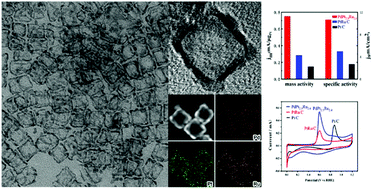PdPtRu nanocages with tunable compositions for boosting the methanol oxidation reaction†
Abstract
PtRu/C is a well-known commercial electrocatalyst with promising performance for the methanol oxidation reaction (MOR). Further improving the MOR properties of PtRu-based electrocatalysts is highly desirable, especially through structure design. Here we report a facile approach for the synthesis of PdPtRu nanocages with different components through a seed-mediated approach followed by chemical etching. The Pd@PtRu nanocubes were first generated using Pd nanocubes as the seeds and some Pd atoms were subsequently etched away, leading to the nanocages. When evaluated as electrocatalysts for the MOR in acidic media, the PdPtRu nanocages exhibited substantially enhanced catalytic activity and stability relative to commercial Pt/C and PtRu/C. Specifically, PdPt2.5Ru2.4 achieved the highest specific (8.2 mA cm−2) and mass (0.75 mA mgPt−1) activities for the MOR, which are 2.2 and 4.2 times higher than those of commercial Pt/C. Such an enhancement can be attributed to the highly open structure of the nanocages, and the possible synergistic effect between the three components.



 Please wait while we load your content...
Please wait while we load your content...